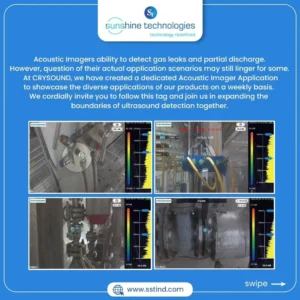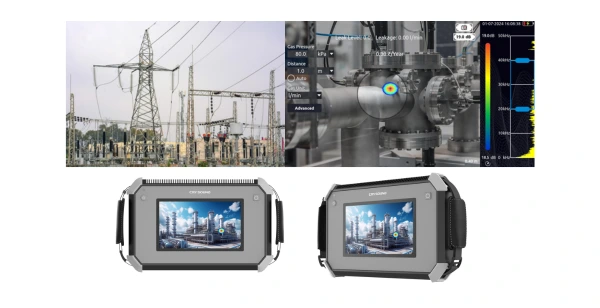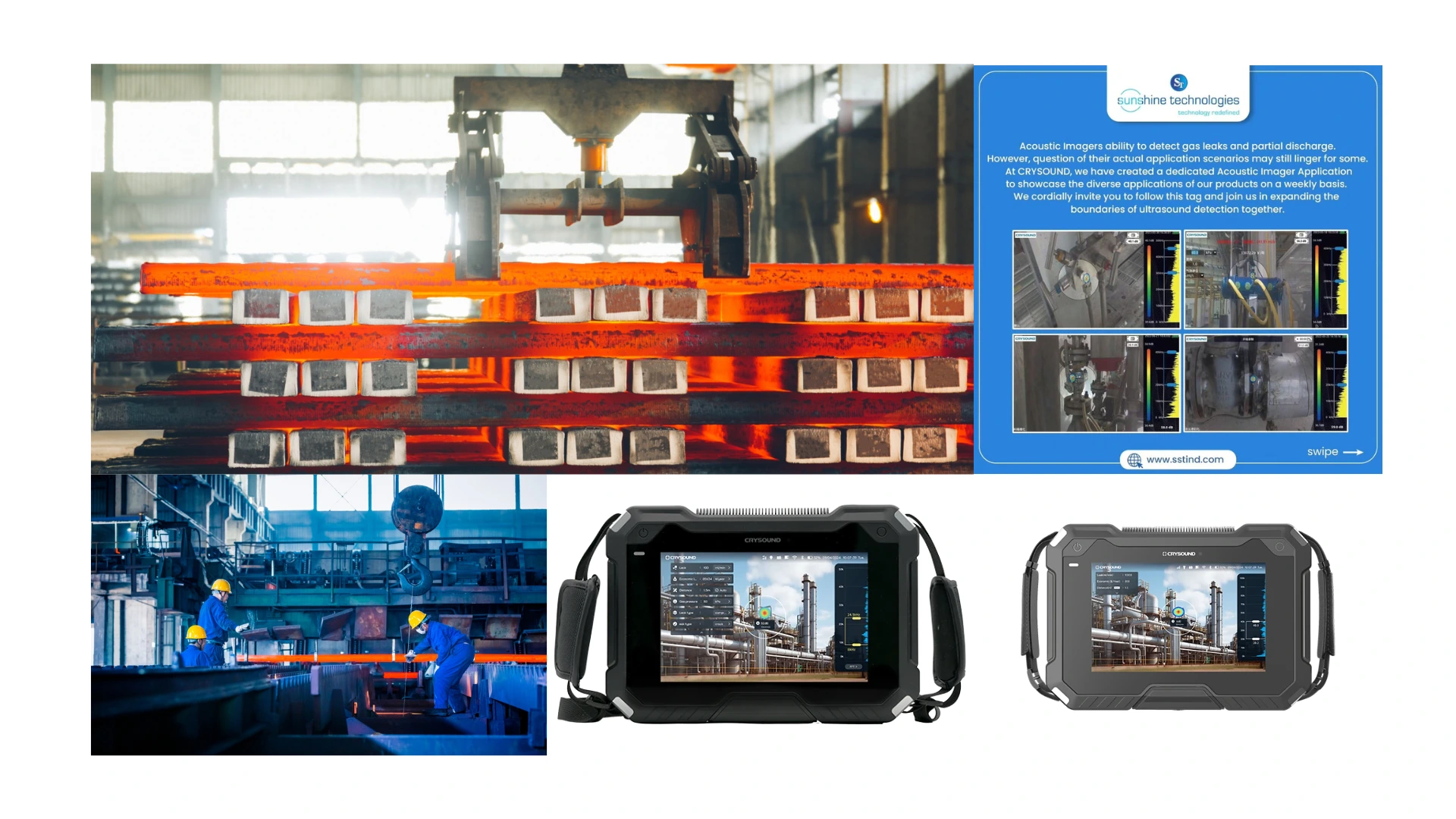
CRYSOUND Acoustic Imaging in Steel Manufacturing – Boosting Productivity and Reducing Costs
How Industrial Acoustic Imaging (CRYSOUND) is Improving Steel Manufacturing
Content Overview:
- Introduction
- Why Innovation is Important for Steel Manufacturing
- Leveraging Acoustic Imaging Technology for Efficiency and Safety
- A Human-Centered Approach to Steel Manufacturing
- A Sustainable Future for Steel Manufacturing
- Conclusion
- Frequently Asked Questions (FAQs)
Introduction:
Steel plays an important role in our day-to-day life, shaping everything from our vehicles to the infrastructure, and building residential and commercial places we live and work in. The steel manufacturing process has faced significant challenges due to outdated practices, despite its vital role in modern infrastructure. For instance, traditional methods are responsible for over 7% of global CO2 emissions and consume vast energy and raw materials. These inefficiencies lead to high production costs and negative environmental impacts.
Traditional ways of manufacturing steel consume a lot of energy and negatively impact the environment. The steel industry consumes about 1.5 billion tons of raw materials annually, often resulting in significant resource wastage. Regular equipment failures, which occur at 5-10% annually in many plants, can lead to costly downtime and maintenance, further increasing production costs and safety risks.
Acoustic imaging technology is proving to be a turning point for the steel industry. This technology detects faults with up to 90% accuracy, allowing manufacturers to identify issues early and prevent major equipment failures. By improving efficiency, acoustic imaging can reduce downtime by 20-30%, leading to smoother production of higher-quality steel. Additionally, it helps cut energy consumption and reduce emissions, making the manufacturing process not only safer for workers but also more environmentally sustainable.
Why Innovation is Important for Steel Manufacturing
The steel industry holds an important position in the world economy, helping drive sectors like transportation, construction, and technology. Steel is so fundamental to our cities, infrastructure, and various products that imagining a world without it is almost impossible. However, the process of making steel is not as efficient or eco-friendly as it could be. Let’s break down why innovation is needed in this important industry.


1. Energy Consumption in Steel Production: Making steel requires a significant amount of energy and power. Whether it’s using blast furnaces or electric arc furnaces, the energy demand is in high volume. The high energy usage not only adds to production costs but is also responsible for environmental concerns like increased carbon emissions. Finding more energy-efficient methods of production would help the industry reduce its impact on the planet.
2. Environmental Impact: Steel manufacturing contributes significantly to global carbon emissions. The process releases large amounts of CO2, making it one of the top contributors to industrial pollution. Additionally, the use of water in steel production is another environmental issue. Water is often used in cooling and processing, and with growing water scarcity concerns worldwide, this usage needs to be reevaluated. Developing new techniques that minimize carbon emissions and water usage is crucial for the industry to become more sustainable.
3. Waste Generation: Managing waste is another challenge in the steel manufacturing process. From slag to dust, the by-products of steel manufacturing often end up in landfills or require complex treatments before they can be reused. Innovations in waste reduction and recycling can help steel producers minimize their carbon footprint on nature while potentially lowering costs.
4. Pressure from Regulations and Consumers: To encourage greener practices, governments worldwide are implementing strict environmental regulations. Steel companies also face the same challenges. At the same time, consumers are becoming more nature-conscious, demanding sustainable products and services. These two forces are putting immense pressure on steel manufacturers to innovate and find solutions that balance production efficiency with environmental responsibility.
5. Balancing Sustainability and Production: The main challenge for the steel industry is how to innovate without sacrificing production outputs. Steel is essential to so many industries, and any disruption in supply could have a global impact. Manufacturers need to find ways to integrate sustainable practices without slowing down their production or increasing costs at higher levels.
Innovation in steel manufacturing is not optional—it’s essential. By finding ways to reduce energy consumption, minimize waste, and meet environmental standards, Steel producers can ensure the industry’s long-term success while also being environmentally responsible. The time to change is now, and companies that adopt new ideas will help create a more sustainable world.
Leveraging Acoustic Imaging Technology for Efficiency and Safety
Introduction to Acoustic Imaging
Advanced acoustic imaging is greatly impacting the steel industry by providing precise detection of problems within equipment and production systems. Instruments such as the CRYSOUND Acoustic Imaging Camera use sound waves to identify problems that are not visible without this technology.
How Acoustic Imaging Works
- Sound Waves for Detection: Acoustic imagers use sound waves to scan machinery and materials. These sound waves bounce off surfaces and help create a visual map of the internal structure.
- Identifying Problems Early: By analyzing these images, manufacturers can find faults or defects that might not be seen otherwise. This early detection helps in addressing issues before they become serious problems.
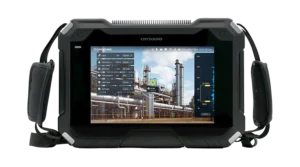

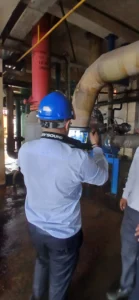
Benefits for Steel Manufacturers
- Increased Efficiency: By detecting and addressing issues early, manufacturers can prevent unexpected equipment failures and avoid costly disruptions in their production lines. This proactive approach ensures that machinery operates smoothly, reducing downtime and maintaining consistent production rates. As a result, overall efficiency is significantly improved, leading to higher output and more reliable operations.
- Reduced Maintenance Costs: Early problem detection through advanced technologies allows for more strategic planning and execution of repairs, leading to major cost savings. By identifying issues before they grow, companies can schedule maintenance activities during planned downtimes rather than facing urgent, often costly emergency repairs. This proactive approach minimizes the likelihood of unexpected breakdowns and allows for more efficient allocation of resources, ultimately reducing overall maintenance expenses and enhancing operational efficiency.
- Better-Quality Steel Output: By minimizing disruptions and maintaining a more controlled production procedure, the overall quality of steel produced sees a notable improvement. Advanced technologies and precise monitoring help ensure that the manufacturing process runs smoothly, reducing the chances of defects and inconsistencies. As a result, manufacturers can produce steel that meets higher standards of strength, durability, and reliability, which is crucial for meeting industry specifications and customer expectations.
Enhancing Workplace Safety
- Preventing Equipment Failures: Acoustic imaging technology plays a crucial role in identifying signs of wear and tear in machinery well before these issues turn into serious failures. By using sound waves to detect internal problems, this technology allows for early intervention and maintenance, thus preventing potentially dangerous equipment malfunctions. This early approach not only extends the lifespan of machinery but also significantly enhances workplace safety by addressing issues before they cause accidents or operational disruptions.
- Avoiding Hazards: Identifying potential issues early allows companies to proactively address them before they cause any serious safety problems. This method helps prevent accidents and injuries by allowing for quick repairs before problems get worse. Fixing issues early makes the workplace safer, protects employees, and avoids costly interruptions.
Acoustic imaging technology in steel manufacturing represents a significant advancement for the industry. This innovative technology enhances operational efficiency by allowing for precise detection of faults and inefficiencies, leading to reduced downtime and lower maintenance costs. Additionally, it plays a vital role in improving workplace safety by identifying potential hazards before they lead to accidents. As acoustic imaging technology continues to get more advanced, its capabilities are expected to further make steel manufacturing much better, offering even greater benefits in terms of efficiency, cost savings, and safety enhancements.
A Human-Centered Approach to Steel Manufacturing
The Role of People in Steel Manufacturing
Steel manufacturing is not alone defined by its advanced machinery and technological processes; it is equally shaped by the people who operate and maintain these systems. A human-centered approach places significant value on the workforce, acknowledging that their well-being and safety are crucial to the industry’s success. This perspective emphasizes creating a work environment that is not only efficient but also supportive and secure for employees. By prioritizing the needs and safety of workers, this approach fosters a more engaged and productive workforce, ultimately enhancing both operational effectiveness and job satisfaction.
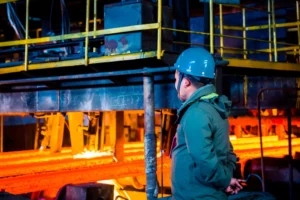
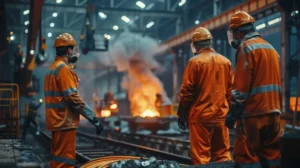
Enhancing Workplace Safety
- Reducing Equipment Failures: Advanced acoustic imaging technology helps detect potential issues in equipment before they lead to failures. This early detection minimizes the risk of accidents, making the workplace safer for employees.
- Boosting Worker Confidence: With fewer unexpected breakdowns and malfunctions, workers can carry out their tasks with greater confidence and peace of mind, knowing that potential hazards are being managed proactively.
Improving Employee Well-Being
- Lowering Workplace Stress: By reducing the likelihood of equipment failures and related accidents, acoustic imaging helps lower stress levels among employees. A safer work environment contributes to a better quality of life for workers.
- Promoting a Healthier Workforce: Less stress and fewer accidents contribute to overall employee health and well-being, creating a more positive and productive work atmosphere.
Supporting Sustainability Efforts
- Energy Efficiency: Acoustic imaging technology helps in identifying inefficiencies in production processes, which can lead to reduced energy consumption. This is crucial as industries worldwide focus on minimizing their energy use.
- Waste Reduction: By detecting issues early, this technology also helps in reducing waste generated during production. Efficient use of resources and reduced waste align with broader sustainability goals.
Contributing to Global Sustainability
Incorporating acoustic imaging into steel manufacturing not only enhances the efficiency of individual workplaces but also aligns with broader sustainability goals. This technology plays a key role in improving energy efficiency by identifying and addressing inefficiencies in production processes, leading to significant reductions in energy consumption. Additionally, by minimizing waste through early detection of issues, acoustic imaging helps in optimizing resource use and reducing environmental impact. As a result, steel manufacturers who adopt this technology contribute to global sustainability efforts, helping to protect the environment and improve the quality of life within their communities.
A human-centered approach in steel manufacturing, supported by advanced acoustic imaging technology, enhances workplace safety, boosts employee well-being, and aligns with global sustainability goals. This comprehensive approach benefits both the industry and the broader environment, demonstrating that technological advancements can be harmoniously integrated with human and ecological considerations.
A Sustainable Future for Steel Manufacturing
As the world moves toward sustainability, the steel industry is under growing pressure to lower its environmental impact while staying efficient. Since steel production uses a lot of energy and contributes to about 8% of global CO2 emissions, finding ways to be more eco-friendly is crucial. Acoustic imaging technology offers a clear solution. It helps steel manufacturers detect faults early, improve efficiency, and reduce energy waste. This technology not only cuts down on emissions but also helps companies meet environmental regulations while boosting production and safety. As sustainability becomes more important, acoustic imaging is set to make steel manufacturing cleaner, safer, and more efficient.
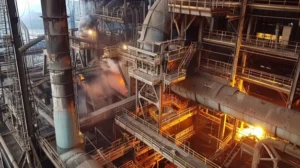

1. Enhancing Production Efficiency: Acoustic imaging technology helps steel manufacturers streamline their operations. By detecting equipment faults and production issues with precision, it reduces the likelihood of breakdowns and costly downtime. This allows manufacturers to run their operations more smoothly, increasing overall efficiency. Companies that have adopted acoustic imaging have reported up to a 20% increase in operational efficiency, thanks to fewer disruptions and optimized maintenance schedules.
2. Reducing Environmental Impact: Steel production accounts for approximately 8% of the world’s CO2 emissions, making it a key source of pollution. By helping manufacturers identify inefficiencies in their production processes, acoustic imaging technology can reduce waste and lower energy consumption. This is crucial for companies aiming to meet stricter environmental regulations. With this technology, manufacturers can cut energy use, reduce resource wastage, and lower their carbon footprint—essential steps in the global movement toward sustainability.
3. Creating Safer Workplaces: Safety is a top priority in steel manufacturing, given the hazardous nature of the industry. Acoustic imaging plays a vital role in creating safer environments by identifying potential equipment failures before they become dangerous. By catching these issues early, manufacturers can prevent accidents and ensure the safety of their workforce. Studies show that companies using advanced fault detection systems like acoustic imaging have reduced workplace incidents by up to 30%, creating a safer environment for employees.
4. Compliance with Environmental Standards: With increasing global regulations around emissions and environmental impact, steel manufacturers must find ways to meet these standards. Acoustic imaging helps by offering insights into how processes can be improved to minimize waste and reduce emissions. By adopting these technologies, manufacturers can stay ahead of regulatory requirements and contribute to a greener planet.
Moving Ahead with Innovation
The integration of acoustic imaging technology represents the future of the steel manufacturing industry. It not only enhances production quality and operational efficiency but also strengthens the industry’s commitment to sustainability and safety. Steel manufacturers with these innovations will not only reduce costs but also position themselves as leaders in the transition to a more sustainable and responsible industry.
As the demand for environmentally responsible manufacturing grows, advanced technologies like acoustic imaging will play an important role in shaping the steel industry of tomorrow—one that’s cleaner, safer, and more efficient.
Our Case Study:


Our Acoustic Imaging Technology (CRYSOUND) Presentation at Petro Chemical Plant
Applications of our CRYSOUND Acoustic Imager (CRY2623/CRY2624, CRY8120/CRY8124)

Conclusion:
The steel manufacturing industry is going through big changes, with acoustic imaging technology playing a key role in improving how things are operated. This advanced technology helps manufacturers find and fix problems in production earlier, which reduces downtime and cuts repair costs. In addition to that, acoustic imaging makes workplaces safer by spotting potential risks before they cause accidents or equipment failures. It also helps companies save energy and meet stricter environmental rules, making the whole process more eco-friendly. Overall, acoustic imaging is helping the steel industry become more efficient, safer, and better for the environment and future generations.
- Enhanced Fault Detection: Acoustic imaging allows manufacturers to detect production faults earlier and with greater precision, reducing costly errors and improving the overall quality of steel products.
- Improved Safety: By identifying issues before they grow into larger problems, this technology also helps create safer work environments, minimizing the risk of accidents and equipment failures.
- Supporting Sustainability: Acoustic imaging technology plays a critical role in reducing energy waste and emissions, helping steel manufacturers meet growing environmental standards and contribute to a greener future.
Incorporating this innovative technology provides steel manufacturers with the tools they need to remain competitive, efficient, and sustainable. As the industry continues to evolve, embracing acoustic imaging is a crucial step toward a more responsible, safer, and forward-thinking approach to steel production.
Stay Connected With Us:
To stay updated on the latest innovations and insights from Sunshine Technologies, explore our website for wide range of Industrial solutions, follow us on Instagram for regular updates, connect with us on LinkedIn for industry updates and networking, like us on Facebook to engage with our community, and subscribe to our YouTube Channel for in-depth product tutorials and technology showcases.
Frequently Asked Questions (FAQs)
1.) What is Acoustic Imaging in steel manufacturing?
Acoustic imaging is an advanced technology that uses sound waves to detect faults in machinery and materials during steel production. It helps identify problems early, allowing manufacturers to fix issues before they become major failures, improving efficiency, and reducing downtime.
2.) How does Acoustic Imaging improve steel manufacturing efficiency?
By detecting faults with up to 90% accuracy, acoustic imaging allows manufacturers to prevent equipment breakdowns. This reduces downtime by 20-30%, leading to smoother production, better-quality steel, and lower maintenance costs.
3.) Why is innovation important in the steel industry?
Innovation is crucial because traditional steel production methods are energy-intensive and environmentally harmful. Acoustic imaging offers a more efficient and eco-friendly solution, helping the industry reduce energy consumption, emissions, and waste.
4.) What environmental benefits does Acoustic Imaging offer to steel manufacturers?
Acoustic imaging helps steel manufacturers reduce their energy consumption and CO2 emissions, which are major contributors to industrial pollution. By identifying inefficiencies early, the technology also reduces waste and supports global sustainability efforts.
5.) What are the cost benefits of using Acoustic Imaging in steel production?
Acoustic imaging allows for early detection of issues, reducing the need for costly emergency repairs and minimizing production interruptions. This proactive approach lowers overall maintenance costs and improves resource efficiency, saving manufacturers time and money.
6.) Can Acoustic Imaging improve the quality of steel products?
Yes, by ensuring a more controlled and efficient production process, acoustic imaging helps minimize disruptions, leading to higher-quality steel that meets industry standards for strength, durability, and reliability.
7.) How does Acoustic Imaging help companies comply with environmental regulations?
Acoustic imaging technology allows companies to identify areas where energy and resource use can be optimized. This helps manufacturers reduce their environmental impact, ensuring they meet stricter emissions regulations and sustainability requirements.



